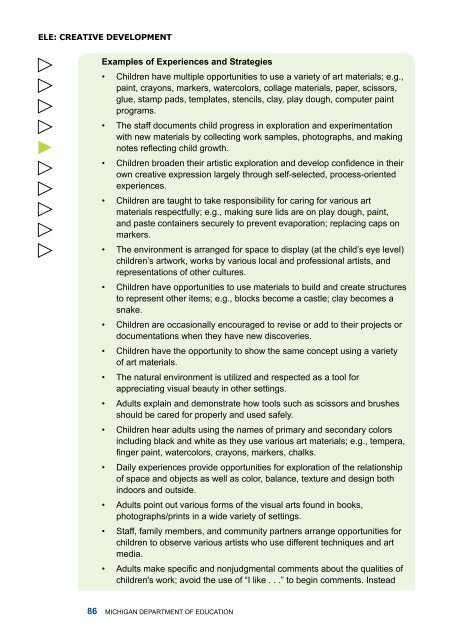Early Childhood Standards of Quality for ... - State of Michigan
Early Childhood Standards of Quality for ... - State of Michigan
Early Childhood Standards of Quality for ... - State of Michigan
Create successful ePaper yourself
Turn your PDF publications into a flip-book with our unique Google optimized e-Paper software.
ELE: Creative DevelopmentExamples <strong>of</strong> Experiences and Strategies• Children have multiple opportunities to use a variety <strong>of</strong> art materials; e.g.,paint, crayons, markers, watercolors, collage materials, paper, scissors,glue, stamp pads, templates, stencils, clay, play dough, computer paintprograms.• The staff documents child progress in exploration and experimentationwith new materials by collecting work samples, photographs, and makingnotes reflecting child growth.• Children broaden their artistic exploration and develop confidence in theirown creative expression largely through self-selected, process-orientedexperiences.• Children are taught to take responsibility <strong>for</strong> caring <strong>for</strong> various artmaterials respectfully; e.g., making sure lids are on play dough, paint,and paste containers securely to prevent evaporation; replacing caps onmarkers.• The environment is arranged <strong>for</strong> space to display (at the child’s eye level)children’s artwork, works by various local and pr<strong>of</strong>essional artists, andrepresentations <strong>of</strong> other cultures.• Children have opportunities to use materials to build and create structuresto represent other items; e.g., blocks become a castle; clay becomes asnake.• Children are occasionally encouraged to revise or add to their projects ordocumentations when they have new discoveries.• Children have the opportunity to show the same concept using a variety<strong>of</strong> art materials.• The natural environment is utilized and respected as a tool <strong>for</strong>appreciating visual beauty in other settings.• Adults explain and demonstrate how tools such as scissors and brushesshould be cared <strong>for</strong> properly and used safely.• Children hear adults using the names <strong>of</strong> primary and secondary colorsincluding black and white as they use various art materials; e.g., tempera,finger paint, watercolors, crayons, markers, chalks.• Daily experiences provide opportunities <strong>for</strong> exploration <strong>of</strong> the relationship<strong>of</strong> space and objects as well as color, balance, texture and design bothindoors and outside.• Adults point out various <strong>for</strong>ms <strong>of</strong> the visual arts found in books,photographs/prints in a wide variety <strong>of</strong> settings.• Staff, family members, and community partners arrange opportunities <strong>for</strong>children to observe various artists who use different techniques and artmedia.• Adults make specific and nonjudgmental comments about the qualities <strong>of</strong>children's work; avoid the use <strong>of</strong> “I like . . .” to begin comments. Instead86 <strong>Michigan</strong> Department <strong>of</strong> Education


